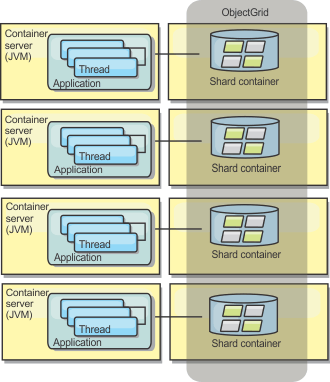Distributed cache
WebSphere® eXtreme Scale is most often used as a shared cache, to provide transactional access to data to multiple components where a traditional database would otherwise be used. The shared cache eliminates the need configure a database.
Coherency of the cache
The cache is coherent because all of the clients see the same data in the cache. Each piece of data is stored on exactly one server in the cache, preventing wasteful copies of records that could potentially contain different versions of the data. A coherent cache can also hold more data as more servers are added to the data grid, and scales linearly as the grid grows in size. Because clients access data from this data grid with remote procedural calls, it can also be known as a remote cache, or far cache. Through data partitioning, each process holds a unique subset of the total data set. Larger data grids can both hold more data and service more requests for that data. Coherency also eliminates the need to push invalidation data around the data grid because no stale data exists. The coherent cache only holds the latest copy of each piece of data.

Near cache

- The transaction tier cache contains all changes for a single transaction. The transaction cache contains a working copy of the data until the transaction is committed. When a client transaction requests data from an ObjectMap, the transaction is checked first.
- The near cache in the client tier contains a subset of the data from the server tier. When the transaction tier does not have the data, the data is fetched from the client tier, if available and inserted into the transaction cache
- The data grid in the server tier contains the majority of the data and is shared among all clients. The server tier can be partitioned, which allows a large amount of data to be cached. When the client near cache does not have the data, it is fetched from the server tier and inserted into the client cache. The server tier can also have a Loader plug-in. When the data grid does not have the requested data, the Loader is invoked and the resulting data is inserted from the backend data store into the grid.
To disable the near cache, see Configuring the near cache.
Advantage
- Fast response time because all access to the data is local. Looking for the data in the near cache first saves a trip to the grid of servers, thus making even the remote data locally accessible.
Disadvantages
- Increases duration of stale data because the near cache at each tier may be out of synch with the current data in the data grid.
- Relies on an evictor to invalidate data to avoid running out of memory.
When to use
Use when response time is important and stale data can be tolerated.